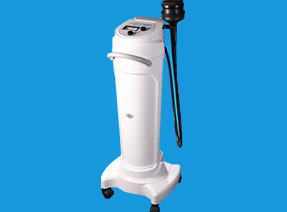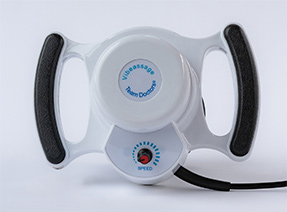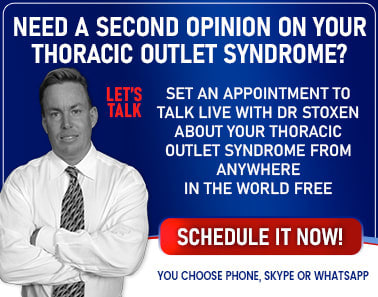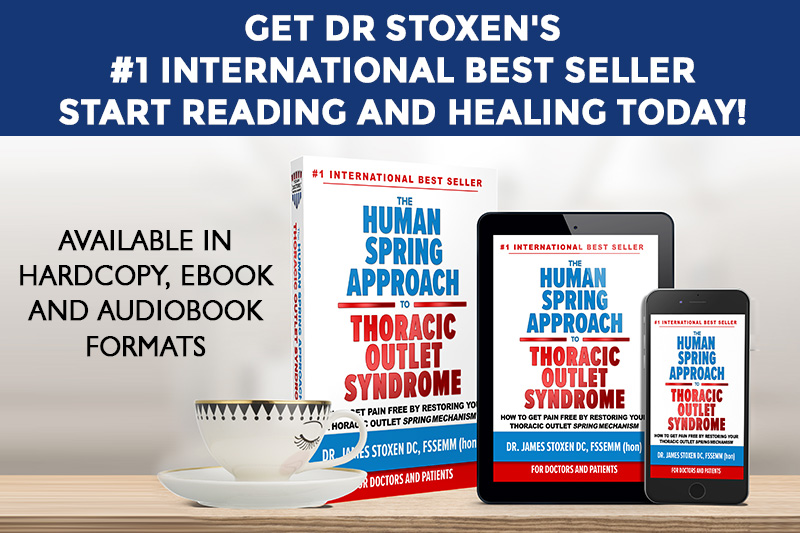THE HUMAN SPRING APPROACH TO
THORACIC OUTLET SYNDROME
by Dr James Stoxen DC., FSSEMM (hon) FWSSEM
SAMPLE CHAPTER
PREFACE
Doctor’s Note:
I Know How You Feel
A prerequisite to empathy is simply paying attention to the person in pain.
—Daniel Goleman
Like many of you, I didn’t know I had thoracic outlet syndrome. Unfortunately, I was misdiagnosed, and mistreated for seven painful years.
This book is written to ensure you don’t end up suffering as I did.
The thoracic outlet (inlet or compartment) is a tunnel under the shoulder and over the rib cage that allows the safe passage of the artery, vein, and nerves that pass from the chest and neck area into the arm and hand.

For most doctors, the anatomy is complex, leading to
more misdiagnosis, which obviously leads to mistreatment (1).
he thoracic outlet anatomy and how the bundle passes through the passageway require an even more complex understanding of anatomy and how the body moves—biomechanics. Subsequently, there is inadequate professional understanding about the thoracic outlet, thoracic outlet syndrome, and what causes it.
If you believe you are getting nowhere being treated for thoracic outlet syndrome, I know how you feel. I suffered from chronic neck pain, chronic upper back pain, constant shoulder pain, arm numbness, and tingling arms and hands, which were misdiagnosed for seven years. What I was suffering from was a bilateral thoracic outlet syndrome.
Here is the really pathetic part of the story.
During that seven-year period, I was a chiropractic student in a top chiropractic college surrounded by teachers who were doctors of chiropractic and experts in chiropractic medicine. I asked for help from everyone, yet, I graduated in chronic pain.
As a licensed chiropractor, I went to every back pain center to consult with physical therapists, sports doctors, orthopedic surgeons, neurologists, family practitioners, neurosurgeons, many massage therapists, and acupuncturists. Then I went to all the sub-specialty medical specialists, such as the back specialist, the sports chiropractor, a neck pain specialist, a shoulder doctor, a spine doctor, a carpel tunnel doctor, pain physicians, and even a specialist called an upper cervical chiropractic physician.
I got opinions from all these doctors, but not one of them could properly diagnose or explain this chronic pain syndrome, which I eventually came to know was TOS.
For every expert I saw, I got a different diagnosis—from a herniated cervical disc, rotator cuff syndrome, pinched nerve in neck, pinched nerves between the thoracic ribs (called intercostal neuritis), and herniated discs in my neck.
I tried almost all the chiropractic techniques taught in chiropractic medicine, involving every way to adjust the spine. The only treatment that helped me was my father’s adjustments for an elevated first rib.
I did a lot of work with massage therapists trying different styles of bodywork, such as manual therapy, neck stretching, nerve gliding, deep tissue therapy, and Swedish message.
When those didn’t provide lasting relief, I tried more drastic measures, such as muscle injections for pain, injections for back pain, and trigger point shots. How long do trigger point injections last?
Most lasted a few days and gave a little relief or no change. How much do trigger point injections cost? Too much!
I eventually started losing my faith in the alternative care approach and started to consult with medical physicians. I was offered just about every approach to treatment, such as nonsteroidal anti- inflammatory drugs (NSAIDS), muscle relaxants for back pain, analgesic drug therapy, and even painkillers for symptom reduction. I did not take the medications.
Some people think of chiropractors as doctors practicing holistic medicine, alternative medicine, or complementary medicine. My father and I practiced together for the first 12 years I was in practice. He was a naturopathic doctor and a good chiropractor. As a naturopathic physician, he offered natural healing with holistic therapy, so I guess you would consider our center an alternative health center.
Toward the end, I was referred to spine doctors. These three orthopedic surgeons and neurosurgeons said, “Well, you tried everything already, so why don’t you try neck surgery or cervical disc surgery?” One doctor examined me for three minutes, did not order magnetic resonance imaging (MRI), and then recommended rotator cuff tear surgery.
I tried many different approaches, which the practitioners all assured me would work. I got no better and, in fact, got progressively worse.
So, if this chiropractic doctor can’t find the right treatment and lifestyle approach to reverse thoracic outlet syndrome after seven years, you shouldn’t feel bad that you haven’t found the solution to your chronic thoracic outlet syndrome symptoms.
In fact, thoracic outlet syndrome is one of the most commonly misdiagnosed, mistreated conditions in medicine. This confusion about thoracic outlet syndrome is why many of you are not finding relief from the chronic suffering.
I was once confused myself, but I discovered why so many doctors have such a difficult time with thoracic outlet syndrome. I have been free from neck pain, upper back pain, shoulder pain, and thoracic outlet syndrome for the past 25 years.
What I found was a huge misunderstanding of human engineering. The secrets are revealed in great detail in this book.
Here Is My Painful Story
While in college, I played rugby for the Las Vegas Rugby Club. The two-hour practices of running and agility drills motivated me, as I knew they were making me run faster and I was at less risk for injury.
This is really important, as I was 140 pounds, playing full-on tackle without pads or a helmet against former, top-university, football players weighing 200–260 pounds.
At 20, I felt I was indestructible. It seemed like it would all last a lifetime until one day in a tournament in Santa Barbara, California, I sustained a whiplash spinal injury that left me with constant neck and shoulder pain, extreme upper back pain, severe pain in the shoulder, and back rib pain. I had symptoms of thoracic outlet syndrome but did not know it until seven years later.
It happened in a scrum, a potentially dangerous pushing-and-shoving competition between 16 players that is an integral part of the game. A scrum is a play that restarts play after a minor violation or penalty. It involves up to eight players from each team jamming, then interlocking, their necks and shoulders.

The scrum is one of the most dangerous plays in rugby, since a collapse
can lead to a player damaging or even breaking his neck.
I was playing hooker, a position in the middle of the rugby scrum. Imagine me, at 140 pounds, being lifted by my shorts off the ground by two, 260-pound, former college linebackers. Then they slammed me into the opposing player’s head, neck, and shoulders like a battering ram and we all interlocked to form the scrum. This also formed a tunnel between both teams.
Scrums are one of the most dangerous plays in rugby, because a collapse can lead to a serious traumatic head injury or spinal trauma, such as an acute spinal cord injury, leading to spinal paralysis or a concussion. You have probably heard the media talking about the dangers of a post-concussion syndrome, leaving the athlete with signs of brain damage. In fact, a top surgeon in the United Kingdom has called for the ban of scrums, asserting they are too dangerous (1) (2).
As the props (the rugby forwards) jammed my neck and shoulders into the opposing team’s props and hooker, both teams started to push. Just as the ball was thrown into the tunnel, I felt the prop next to me slip in the mud. He fell, thrusting me headfirst into the puddle of mud, until my head struck the hard, clay bottom.
As my forehead hit the hard clay, I felt my neck snap like a twig. I felt a tingling pain shoot through my entire body, and then I had numb arms and legs, as if I had a spinal paralysis. Then the weight of our entire team of 2,000 pounds of players piled on my rib cage and back, causing severe, sharp, stabbing rib, chest, and back pain.
The weight of the players piled on me collapsed my rib cage, as the air was forced out of my lungs. I had the wind knocked out of me and I was underwater. I gasped for air—only to inhale mostly muddy water in my nose and mouth. I was drowning.
Finally, the huge hand of my teammate, Dave Handwerker, latched on to me, and I was lifted out of the water. All I remember as they carried me off the field was this excruciating pain under my right rib cage.
My fourth, fifth, and sixth ribs had broken like toothpicks. When I took a breath in, I could feel a sharp lower neck pain and a sharp pain between the shoulder blades. I remember telling the team sports chiropractor that my arm felt numb, my hands felt tingly, and I felt my fingers going numb.

The players of the Las Vegas Rugby Club with Dave Handwerker, the player that rescued me from drowning when submerged in 6 inches of mud and water at a tournament in Santa Barbara, California.
I had a period of unresponsiveness, nausea, vomiting, and dizziness, with vision problems for a few days, which I later found out, was a post-concussion syndrome.
I went to our team doctor, a chiropractor, who examined me, took me out of the tournament and later significantly reduced my neck stiffness and pain, upper back strain symptoms, and helped alleviate my neck shoulder and arm pain. After my positive experience with this sports chiropractor, I called my father, Dr. Paul Stoxen, also a chiropractor, and told him I wanted to study chiropractic medicine to be a top sports medicine chiropractor.

Dr James Stoxen DC, FSSEMM (Hon) and Dr Paul Stoxen DC
at the National Fitness Hall of Fame induction ceremony in 2008
The Neck and Upper Back Pain I Got from Learning How to Treat Neck Pain
A year later, I was at National College of Chiropractic in the western suburbs of Chicago, Illinois, studying my passion in the fast track, taking between 18 and 27 credits, three semesters a year, and between 24 and 27 credits in the summer.
The problem was that sitting with my head down, studying 12 hours a day, aggravated my chronic neck, upper back, and shoulder pain. It was called “student syndrome” back then. It would be called “office syndrome” or “computer syndrome” now. You know, the muscle spasms in the neck, neck stiffness and pain, the chronic upper back pain, sore neck, and shoulders and lower back pain while sitting for hours or working for a long time at the computer.
Next Injury? Car Accident . . . Rear-Ended . . . Whiplash!
Then to make matters worse, I got rear-ended by a drunk driver going 70 mph, which caused a whiplash effect on my upper spine! I remember on impact that I had sudden upper back pain and sharp middle back pain. I suffered from the typical whiplash injury symptoms, the cervical sprain symptoms of extreme neck pain, constant upper back pain, severe middle back pain, shoulder muscle pain, and shoulder pain at night when I turned over in bed.
I suffered a head trauma from hitting my head on the steering wheel, which caused a head contusion. I was diagnosed with a mild concussion but the doctor in the emergency room said I had no signs of brain damage.
I remember that my ribs hurt! When I breathed, I could feel rib cage pain from the separation of the broken ribs. It was such intense rib pain that it took my breath away.
I started to wake up with swollen hands in the morning. I started to suspect carpal tunnel syndrome. In my work as a chiropractor, I’d do 10 to 12 hours of trigger point therapy per day. I thought the swelling was coming from too many myofascial trigger points or pain points. Then I switched the trigger point therapy techniques to take the pressure off my hands, but the swelling in my hands did not go away. Even when I did not do hands-on treatment, I had swollen hands.
I recognized later that the swollen hands were not a sign of carpal tunnel syndrome. I did not have the wrist pain. Also, when I took a photo of both arms and hands side by side, I noticed my forearm on the right was thicker, more swollen than the left. The signs of carpal tunnel syndrome swelling are only from the wrist down and not in the forearm, arm, or shoulder. What was causing my swollen hands and fingers?
I did not know that the swelling in my arms was a sign I had a vascular thoracic outlet syndrome. No one told me that if the muscle spasms in my neck and shoulder got bad enough I could get costoclavicular syndrome or compression of my collarbone to my rib cage. If the compression of the vein gets bad enough, a blood clot can form.
If the clot, or thrombus, breaks off, it becomes a pulmonary embolism. A clot would have traveled to my lungs, causing a lung infarction, which is the death of lung tissue due to inadequate blood supply to the cells. I could have died.
You are probably thinking, what I was thinking. That won’t happen to me. That is what the other 600,000 people in the United States probably thought before they had a pulmonary embolism. What did the 60,000 who died from it think? They didn’t have much time to think, because most of those who die, do so within 30 to 60 minutes after symptoms start.
One of the worst complications of my chronic undiagnosed thoracic outlet syndrome was the effect on my social life. I couldn’t find a good chiropractor near me, so I started cracking my neck. This neck cracking started once every few days. Then the neck popping happened every day. Then my neck started cracking when I wasn’t trying to crack it, like when I was close to my date in a romantic moment!
I called my father and asked him, “Is it bad to crack your neck?” “Are you cracking your neck? Stop doing that or you will get a pinched nerve!” he admonished me. I should have listened to him, but I didn’t.
I got to the point where I developed motor tics in my neck that were noticeable.
These are nervous tics that feel like muscles jumping in the neck. I had excessive muscle twitching that would show up as shoulder twitching or neck twitching. It felt like an involuntary twitching of muscles, because I didn’t know I was doing it.
It was really bad when I went on a date with this beautiful girl I really liked. She asked me, “What are these muscle twitches you do constantly?” Your neck keeps twitching.” She noticed my arm twitching and shoulder twitching too. “You have these twitching movements all the time! Are you nervous, or is there something wrong with you?”
I told her the truth, looking for sympathy. “I know I have twitching muscles. My muscles twitch, because I have over-reactive twitching nerves from muscle spasms all over my neck and shoulders. These chronic continuous muscle spasms lead to muscular twitching.”
The next question was, “What do you do for a living?” I told her, “I’m studying to be a chiropractor.” “Oh, I see,” she commented, combined with a shake of her head movement. Then I’ll never forget what she asked me next, “Why don’t you go to the doctor for some treatment?”
I guess I looked fairly pathetic to her, unable to solve my own problem. What she didn’t realize was that none of the doctors I’d seen could solve my problem! I knew this spasmodic twitching would not only affect my love life but also my professional reputation. Who would go to a chiropractor who has a twitching neck?
I desperately needed help.
My father was a chiropractor. His first rib adjustments helped me a lot. Unfortunately, I would have to drive one hour to his office and then another hour back to school. By the time I got back to school, my pain had returned. I couldn’t spend 2.5 hours of treatment and travel, just to feel the same. After many months, I asked my father, “How long does whiplash last?”
He said that sometimes people have whiplash syndrome pain that lasts for the rest of their life.
The chronic rib pain caused by the inflammation of the rib cage from the twisted and broken ribs was becoming daily, upper middle back pain. One chiropractor had a referred pain chart and told me I had fibromyalgia pressure points or fibromyalgia trigger points. To some doctors, if patients have chronic pain syndrome, muscle pain, or body pain, and they can’t get rid of it, it must be fibromyalgia.
No one seems to know how to clearly define fibromyalgia, how to diagnose fibromyalgia, how to cure fibromyalgia, or even the best treatment for fibromyalgia, but there is a medication for fibromyalgia.
Numbing the brain with drugs for a few hours wasn’t an option, as I was committed to finding the cause and permanent, drug-free solution for this chronic pain!
Patients often feel there is no cure for fibromyalgia, so they think they have to just go on living with fibromyalgia. This is why you see many patients with fibromyalgia and depression in fibromyalgia support groups.
Natural healing was failing me. I almost quit my healthcare profession and considered going on disability.
- Why weren’t the adjustments working?
- Why wasn’t exercise working?
- Why wasn’t anything working?
- Doesn’t natural healing work?
When do you lose hope, give up, and just live with the pain?
When do you get so frustrated that you beg the doctor to cut the pain out of your body? Yes, I contemplated surgery. Thank God, I still remained a rational thinker.
Can surgery cut out the pain? NO!
When do you turn to painkillers? When do you stop taking painkillers?
When do you give up? Giving up means a lifetime of pain. That is what I was contemplating.
Is that what you are contemplating?
Please don’t!
I know how you feel right now.
I felt that same way.
I found my way out of pain, and I can help you like I’ve helped thousands of others.
Please read on, be optimistic, and prepare for the aha moments!
References
- Burry HC, Gowland H. Cervical injury in rugby football—a New Zealand survey. Br J Sports Med. 1981 Mar;15(1):56- 9. http://www.ncbi.nlm.nih.gov/pmc/articles/PMC1859087/
- Freitag A1, Kirkwood G1, Scharer S1, Ofori-Asenso R1, Pollock AM1. Systematic review of rugby injuries in children and adolescents under 21 years. Br J Sports Med. 2015 Apr;49(8):511-9. doi: 10.1136/bjsports-2014-093684. Epub 2015 Jan 6. http://www.ncbi.nlm.nih.gov/pubmed/25564004

Meet Dr James Stoxen DC., FSSEMM (hon)
President, Team Doctors® Masters Academy
www.drstoxen.com
Dr Stoxen’s Curriculum Vitae
Stay connected to our thoracic outlet syndrome social media sites
1.1k
Members

READ THESE CHAPTERS OF DR STOXENS BOOK FREE HERE!
ARTICLE CATEGORIES
- Testimonials (13)
- Success Stories (13)
- Failed TOS Surgery (1)
- Thoracic Outlet Syndrome (11)
- Compartment Syndrome – Forearm (5)
- Shoulder Replacement Surgery (1)
- Cervical Discectomy (1)
- Cervical Fusion Surgery (1)
- What is TOS? (3)
- Thoracic Outlet Anatomy (1)
- Thoracic Outlet Engineering (1)
- Causes Of TOS (6)
- The TOS Examination (1)
- Diagnostic Tests for TOS (1)
- What Mimics TOS? (1)
- Paget-Schroetter Syndrome (2)
- TOS Surgery (2)
- Posture Tips (1)
- Self Treatment (1)
- What doesn’t work and why? (1)
- What works and why? (1)
- Stretches for TOS (1)
- Exercises for TOS (1)
- Surgery for TOS (1)
- Case Studies (2)
- Chapter Reviews (10)
- Uncategorized (16)
VIDEO TUTORIALS
Subscribe to our newsletter
Team Doctors® Master’s Academy
Professional Development Courses
Launching January 1, 2022!
Team Doctors® Master’s Academy
Patient Self-Care Workshops
Launching January 1, 2022!


















